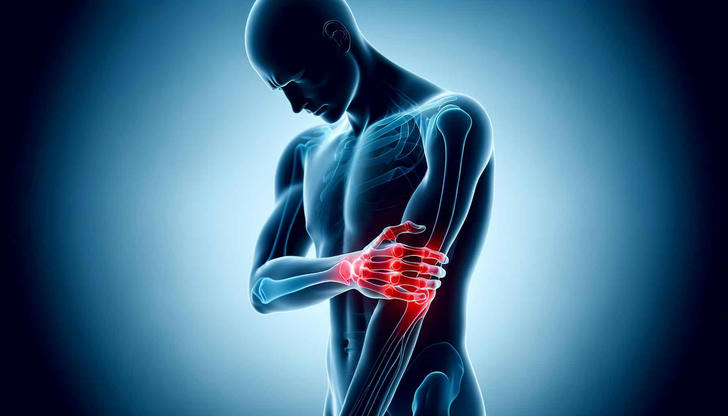Beware! The 'joint trap' of psoriasis patients, psoriatic arthritis cannot be ignored
Psoriatic arthritis (PsA) is a chronic inflammatory joint condition that often occurs in association with psoriasis, a skin disease characterized by red, scaly patches. It affects approximately 30% of people with psoriasis. PsA can cause significant pain, stiffness, and disability if not properly managed.

Symptoms of Psoriatic Arthritis
The symptoms of psoriatic arthritis can vary widely among individuals. Common manifestations include:
Joint Pain and Swelling: This can affect any joint but is often seen in the fingers and toes, causing a sausage-like appearance.
Skin and Nail Changes: Psoriasis-related skin lesions and nail pitting or discoloration are frequently observed.
Enthesitis: Inflammation at the sites where tendons or ligaments insert into the bones, commonly affecting the Achilles tendon or the soles of the feet.
Dactylitis: Swelling of an entire finger or toe.
Axial Involvement: Inflammation in the spine or sacroiliac joints, leading to back pain.
Fatigue: Often underestimated, fatigue can significantly impact the quality of life for patients.
Diagnosis of Psoriatic Arthritis
Diagnosing psoriatic arthritis involves a combination of clinical assessment, imaging studies, and sometimes laboratory tests. The Classification Criteria for Psoriatic Arthritis (CASPAR) are widely used to help confirm the diagnosis. Key steps include:
Clinical Evaluation: Assessing the affected joints, skin, and nails.
Imaging: X-rays, MRI, or ultrasound can help identify joint damage or inflammation.
Laboratory Tests: Although there is no specific blood test for PsA, tests like erythrocyte sedimentation rate (ESR) or C-reactive protein (CRP) can indicate inflammation.
Treatment of Psoriatic Arthritis
Managing psoriatic arthritis requires a multifaceted approach tailored to the individual's symptoms and disease severity. Treatment options include:
Nonpharmacological Measures
Patient education
Physical therapy
Occupational therapy
These measures can help improve joint function and overall well-being.
Medications
Nonsteroidal Anti-inflammatory Drugs (NSAIDs)
NSAIDs are commonly used to manage mild to moderate pain and inflammation in various conditions, including psoriatic arthritis. They work by inhibiting the production of prostaglandins, which are chemicals that cause inflammation and pain.
Benefits of NSAIDs:
Pain Relief: Effective in reducing pain associated with mild to moderate inflammation in PsA.
Reduced Inflammation: By decreasing the production of prostaglandins, NSAIDs can help reduce swelling and inflammation in the affected joints.
Improved Function: With reduced pain and inflammation, patients may experience improved joint function and mobility, allowing them to engage in daily activities more easily.
Convenience: Available in various forms, including oral tablets, capsules, and topical gels, making them accessible and easy to use.
Side Effects of NSAIDs: While NSAIDs offer significant benefits, they also come with potential side effects, especially with long-term or high-dose use. Common side effects include:
Gastrointestinal Issues: NSAIDs can cause irritation of the stomach lining, leading to symptoms such as indigestion, heartburn, nausea, and, in severe cases, ulcers or gastrointestinal bleeding. This risk is higher in individuals with a history of gastrointestinal problems or those taking other medications that increase the risk of bleeding.
Kidney Damage: Long-term use of NSAIDs can affect kidney function, particularly in individuals with pre-existing kidney disease or those who are dehydrated. Regular monitoring of kidney function is recommended for patients on chronic NSAID therapy.
Cardiovascular Risks: Some NSAIDs, especially COX-2 inhibitors, have been associated with an increased risk of cardiovascular events, such as heart attacks and strokes. This risk is generally higher with higher doses and longer duration of use.
Other Side Effects: NSAIDs can also cause other side effects, including dizziness, headache, and allergic reactions.
Disease Modifying Antirheumatic Drugs (DMARDs)
Methotrexate: Can slow disease progression.
Biologic Therapies
Tumor Necrosis Factor (TNF) Inhibitors: Target specific parts of the immune system, such as etanercept and infliximab, which have shown significant efficacy in reducing symptoms and improving quality of life.
Interleukin Inhibitors: Examples include ustekinumab.
T Cell Costimulation Modulators: Additional targeted therapies.
The Role of NSAIDs in Psoriatic Arthritis
Nonsteroidal anti-inflammatory drugs (NSAIDs) are a class of medications commonly used to manage mild to moderate pain and inflammation in various conditions, including psoriatic arthritis. They work by inhibiting the production of prostaglandins, which are chemicals that cause inflammation and pain.
Key Points About NSAIDs:
Effectiveness: NSAIDs are effective in reducing pain and inflammation associated with PsA.
Accessibility: Available in oral and topical forms, making them easy to use.
Risks: Long-term or high-dose use can lead to gastrointestinal, kidney, and cardiovascular issues.
Conclusion
Psoriatic arthritis is a complex and debilitating condition that requires comprehensive management. Early diagnosis and appropriate treatment, including nonpharmacological measures and medications like NSAIDs, DMARDs, and biologic therapies, are essential to improving the quality of life for patients. While NSAIDs provide significant relief from pain and inflammation, their long-term use should be carefully monitored due to potential side effects. A personalized approach to treatment, combined with regular follow-ups and guidance from healthcare providers, is key to effectively managing PsA and minimizing its impact on daily life.
Click the link for more information about arthritis.
